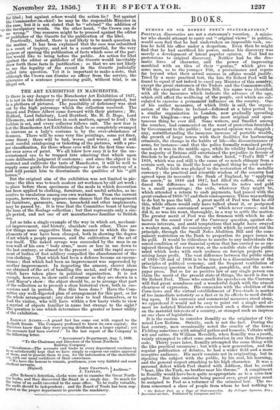THE ART EXHIBITION IN MANCHESTER.
IF there is any danger to the Manchester Art Exhibition of 1857, it is not in the deficiency of pictures which some anticipated, but in a plethora of pictures. The possibility of deficiency was shut out by the high patronage which the collection received. The Queen and Prince Albert came forward' with their pictures ; Mr. Raiford, Lord Salisbury, Lord Hertford, Mr. H. D. Hope, Lord Ellesmere, and other leaders in such matters, agreed to lend ; the fashion is set, and every collector follows suit. The new fear is lest the Manchester Art Exhibition shall be as completely swamped in canvass as a lady's costume is by the over-abundance of flounces. There will be some very fine paintings, some yet finer, some finest ; there will be bad, worse, and worst ; and it will need careful cataloguing or ticketing of the pictures, with a pro- per classification, for those whose eyes will for the first time wan- der over acres of paint. We all know how easy it is for the un- accustomed eye to be trapped into admiring that which upon more deliberate judgment it contemns ; and since the object is to instruct and cultivate the taste of Manchester, it will be well to supply some guide for discriminating—so far as the courtesy of a host will permit him to discriminate the qualities of his ' gift horses."
But the original aim of the exhibition was not limited to pic- tures : the idea was to teach modern art workmen by old art work ; to place before them specimens of the mode in which decoration has been applied to clothing, furniture, and useful articles, as in- centive to emulation among our own workmen. From the current reports, however, there appears some chance that the arrangement for furniture, garments, arms, household and other implements, may be passed by. It is true that the Committee boast of having the loan of the Soulage collection; but that represents only a sin- gle period, and not one of art man:dad-urea familisr to British use.
Let us take a single example of the way in which art, mechani- cal improvement, and history, elucidate each other. There are few things more suggestive than the manner in which the im- plements of war have been changed, both in showing the degree of art which a people possesses, and the cultivation of the art of war itself. The naked savage was succeeded by, the man in an iron wall of his own " body arms," more or less in use down to the last century or almost to the present ; until the rapid move- ment of bodies Of foot soldiery compelled the abandonment of the iron clothing. That which had been a defence became an encum- brance; that which had been an improvement was superseded by another improvement. In inspecting the armour, clearer ideas are obtained of the art of handling the metal, and of the changes which have taken place in political organization. It is not enough, however, to show suits of armour as they are shown in a Lord Mayor's show: the object should be, so to arrange that part of the collection as to present a clear historical view, both in suc- cessions and in periods. Has this been done ? Have the Com- mittee any well-digested plan of arrangement for this part, or for the whole arrangement; any clear idea to lead themselves, or to lead the visitor, who will have within a few hasty visits to view a myriad of objects familiar in name but strange to the sight? The question is one which determines the greater or lesser utility of the exhibition.


























 Previous page
Previous page